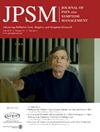Development of an Explanatory Model of Resuscitation Preference Decision Making
IF 3.5
2区 医学
Q2 CLINICAL NEUROLOGY
引用次数: 0
Abstract
Context
Establishing resuscitation preferences prior to a medical emergency is a well-recognized component of hospital practice. When done effectively, these help to ensure that care received aligns with patient wishes. In practice however, these conversations can be challenging and influences on choice are not well understood.
Objectives
Objectives: The purpose of this study was to identify influences on patient resuscitation preferences and their relationship to each other, with the aim of developing an explanatory model.
Methods
Constructivist grounded theory was used to analyze 107 clinical notes from a dataset of detail-rich resuscitation preference conversation narratives. Sampling was purposeful and focused on maximum variation. Iterative data collection and analysis and constant comparison was used to enhance rigor as was the incorporation, in later stages of the analysis, of existing theories and models.
Results
Twenty-seven coding categories were developed and integrated into the resuscitation preferences conversation model that described the interaction and relationship between influences. Within the model, three categories (Ability to Engage in Meaningful Activity, Trajectory, and Perceptions and Beliefs) informed patient and Substitute Decision Maker (SDM) preferences, while an additional two categories (Social and Knowing, and Experiences) informed substitute decision maker choice.
Conclusions
The developed model builds on prior work and helps explain the relationship between influences and preferences. The integration of both patient and substitute decision maker perspective into the model shows the complexity of the substitute decision maker role in decision-making. The model should be used in conjunction with existing conversation guides to support effective resuscitation preference conversations.
复苏偏好决策解释模型的建立。
背景:在医疗紧急情况之前建立复苏偏好是医院实践中公认的组成部分。如果做得有效,这些有助于确保所接受的护理符合患者的愿望。然而,在实践中,这些对话可能具有挑战性,对选择的影响也没有得到很好的理解。本研究的目的是确定对患者复苏偏好的影响及其相互关系,目的是建立一个解释模型。方法:运用建构主义理论对107份临床记录进行分析,这些记录来自一个细节丰富的复苏偏好对话叙述数据集。抽样是有目的的,重点是最大的变化。采用了反复的数据收集和分析以及不断的比较来提高严谨性,在分析的后期阶段也采用了现有理论和模型。结果:27个编码类别被开发并整合到复苏偏好对话模型中,该模型描述了影响之间的相互作用和关系。在模型中,三个类别(参与有意义活动的能力,轨迹,感知和信念)告知患者和替代决策者(SDM)的偏好,而另外两个类别(社会和知识,以及经验)告知替代决策者的选择。结论:开发的模型建立在先前的工作基础上,有助于解释影响和偏好之间的关系。将患者视角和替代决策者视角整合到模型中,显示了替代决策者在决策中角色的复杂性。该模型应与现有的对话指南结合使用,以支持有效的复苏偏好对话。
本文章由计算机程序翻译,如有差异,请以英文原文为准。
求助全文
约1分钟内获得全文
求助全文
来源期刊
CiteScore
8.90
自引率
6.40%
发文量
821
审稿时长
26 days
期刊介绍:
The Journal of Pain and Symptom Management is an internationally respected, peer-reviewed journal and serves an interdisciplinary audience of professionals by providing a forum for the publication of the latest clinical research and best practices related to the relief of illness burden among patients afflicted with serious or life-threatening illness.

 求助内容:
求助内容: 应助结果提醒方式:
应助结果提醒方式:


